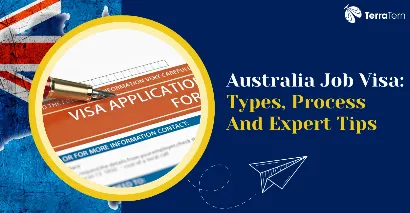Key Highlights
- Latest Facts and News
- Types of Australia Job Visas
- Australia Job Visa Requirements for Indians & Foreigners
- Australia Job Visa Process: Latest Process 2025
- Australia Job Visa for Indians
- Expert Tips for a Successful Australia Job Visa Application
- Life and Work in Australia for Visa Holders
- Pathways to Permanent Residency in Australia for Indians & Foreigners
- Conclusion
Dreaming of working in Australia? International workers have consistently selected Australia as their dream destination because it provides excellent career development opportunities combined with remarkable life quality standards and energetic professional possibilities. Professionals from all nations choose Australia because it offers a mix of business sectors and advanced labour conditions and maintains optimal work-life harmony. The immigration programs target various professional qualifications, thus enabling global job seekers to obtain employment in Australia with numerous visas for different skill groups and market requirements.
Australia extends professional opportunities and is a great place to immigrate to for experienced healthcare workers, engineering specialists, information technology professionals and skilled trades individuals. Besides student visas and practical experience visas, the nation provides entrance options to new job seekers who wish to continue their education or upgrade their qualifications. Australia provides job seekers with attractive future possibilities due to its stable career market and advancement potential.

Latest Facts and News
Australia's immigration policies have seen significant developments in recent years, reflecting the country’s evolving approach to managing its job visa landscape. Here are some of the latest updates that are shaping the work visa sector in Australia:
-
The Pacific Engagement Visa began operating in July 2023 to benefit up to 3,000 Pacific Island citizens with permanent residency placement. Australia introduced this policy as part of its active Pacific partnership building and its scheme to welcome labour migrants from the region.
-
The Australian government established Migrant Intake Reduction, which plans to decrease migrant acceptance levels by fifty per cent before June 2024. This staffing modification goals for resource alignment between population expansion and national capacity which affects visa availability and might result in longer processing durations.
-
More than 70 visa options are currently available to individuals who want to work, study or migrate to Australia starting January 2024. Australia works to provide visa options for all types of workers regardless of their industry specialism skill level or personal requirements.
-
The Australian government is evaluating new adjustments to the Working Holiday Maker (WHM) program to reduce labour shortage problems in regional areas. The government plans to implement new policy changes affecting the age requirements, visa duration,s and work limitations to let young employees readily accept temporary positions throughout agriculture, hospitality, and other struggling sectors lacking enough local employees.
-
TSS Visa holders must now earn a minimum wage of AUD 70,000 per year because of the increased salary threshold since 2023. Foreign workers receive just compensation under this adjustment because it ensures their skills get paid fairly according to Australia's developing economy and elevated lifestyle standards.

Also read: Immigration To Australia: Everything You Need To Know
Types of Australia Job Visas
Australia offers multiple job visa options for skilled professionals, temporary workers, and employer-sponsored applicants. Below is an overview of the most common visa categories:
Temporary Skill Shortage (TSS) Visa (Subclass 482)
-
This category allows businesses to support highly skilled overseas employees seeking temporary employment under their sponsorship.
-
Three streams: Short-Term, Medium-Term, and Labor Agreement.
-
Workers need both employer sponsorship and successful skills assessment performance.
-
The processing period for this visa application is from 4 months to 12 months.
-
Minimum salary requirement: AUD 70,000 per year.
Skilled Independent Visa (Subclass 189)
-
Points-based visa for skilled workers without employer sponsorship.
-
Migration through this visa requires a nomination from a profession listed on the Skilled Occupation List.
-
To qualify for entry, an applicant needs both age requirements and proficiency in English, as well as work experience and education standards.
-
Grants permanent residency.
Employer Nomination Scheme (ENS) Visa (Subclass 186)
-
The scheme enables Australian businesses to recruit international employees for Australian permanent residency.
-
Three streams: Direct Entry, Temporary Residence Transition, and Labor Agreement.
-
To qualify applicants need to fulfill the skills requirements along with professional experience and demonstrate sufficient English language ability.

Australia Job Visa Requirements for Indians & Foreigners
To qualify for an Australian work visa, applicants must meet key Australia job visa requirements, including skills assessment, English proficiency, and health and character checks.
-
Skills Assessment:
-
Designated assessment authorities evaluate qualifications together with experience verification.
-
Mandatory for visas like Subclass 189, 186, and some streams of Subclass 482.
-
English Language Proficiency:
-
Students can demonstrate their English proficiency through IELTS, PTE, TOEFL, and OET tests, but different visa categories have different score requirements.
-
TSS guides a potential candidate through its visa requirements with an IELTS score of 5.0, yet Skilled Independent Visa (Subclass 189) assessment demands a minimum test score of 6.5 or superior.
-
Health and Character Requirements:
-
Any medical examination must be conducted by physicians selected by official government panels.
-
Candidates need to provide police clearance documentation that covers their residence in any country for more than twelve months from the past decade.
-
For certain professions, the authorities may demand extra examination procedures.
Fulfilling these Australia job visa requirements ensures a smoother process towards obtaining an Australia job visa.
Also Read: Australia Transit Visa from India: Get the Latest Details
Australia Job Visa Process: Latest Process 2025
Applying for an Australian work visa involves multiple steps in the Australia job visa process, from creating an account to submitting documents and fees.
-
Creating an ImmiAccount:
-
People need ImmiAccount to submit and monitor their visa applications through the online platform.
-
Immigration authorities use this platform to deliver documents and communication updates to users.
-
Gathering Required Documents:
-
Identity proof: Passport, national ID, or birth certificate.
-
Those applying need to provide records of their education alongside their employment history to confirm their qualifications.
-
The required English language assessment must include results from IELTS, PTE, TOEFL, and OET.
-
Skills assessment certificate (if applicable).
-
The visa application requires two essential documents, including a medical exam and a police certificate for health and character clearance.
-
Lodging Your Application:
-
Visitors need to fill out their application through the Home Affairs website system.
-
The application requires visa processing fee payment according to your chosen visa type.
-
Submit biometric data if requested.
-
Visa processing durations differ between categories together with their unique set of circumstances.

Following these steps during the Australia job visa process can prove to be crucial in obtaining an Australian job visa.
Australia Job Visa Fees by Visa Type
Australia job visa fees for application vary based on the visa type and number of applicants. Below is an estimated breakdown:
|
Visa Type |
Primary Applicant Fee (AUD) |
Primary Applicant Fee (INR) |
Additional Applicant Fee (AUD) |
Additional Applicant Fee (INR) |
|
TSS Visa (Subclass 482) |
$1,455 - $2,645 |
80,025 - 145,475 |
$1,455 |
80,025 |
|
Skilled Independent Visa (Subclass 189) |
$4,640 |
255,200 |
$2,320 |
127,600 |
|
Employer Nomination Scheme (Subclass 186) |
$4,640 |
255,200 |
$2,320 |
127,600 |
Additional Costs to consider apart from Australia job visa fees:
-
The amount for a skills assessment ranges from AUD 500 to AUD 2000, based on which authority performs the assessment.
-
English Test: AUD 300 - 500 for IELTS, PTE, or other accepted exams.
-
Health Examination costs AUD 350-600, which is fundamental for visa approval.
-
The price for police clearance ranges between AUD 50 and AUD 20,0, depending on your current living situation.
You need to verify official sources about current expenses because payment amounts differ depending on your professional visa category and assessment authority.

Australia Job Visa for Indians
Australian employment opportunities, along with rewarding compensations and active recruitment for specialised workers, draw numerous Indian professionals seeking Australia job visa for Indian:
Popular Industries for Indian Workers in Australia:
-
Software developers, programmers, cybersecurity experts, and software engineers maintain strong employment demands in the IT and software development fields.
-
The healthcare industry and nursing demand an increasing number of medical staff, including doctors, nurses, and allied health personnel.
-
Young engineers possess career opportunities across civil mechanical and electrical engineering domains.
-
Skilled labourers, electricians, and project managers comprise the top positions needed in the Construction & Trades sector.
-
Finance & Accounting services within banking institutions hire personnel to work in taxation audit fields and banking management.
Bilateral Agreements and Special Programs:
-
Through the Australia-India Economic Cooperation and Trade Agreement (ECTA) Indian professionals gain better access to markets as well as professional opportunities in the Australian workforce.
Through the 457 & TSS Visa Pathways, Indian workers can access Australia job visa for Indian and employer-based positions, which lead them to permanent residency after accumulating necessary work experience in Australia.
Expert Tips for a Successful Australia Job Visa Application
The Australia job visa application process for Australian job visas includes several complex steps through which mistakes can produce delays or cause your application to be denied. The following steps for Australia job visa application will boost your probability of submission approval when applying for an Australian job visa:
Common Mistakes to Avoid
-
Incomplete Documentation:
Visa delays and denials frequently occur because applicants fail to provide necessary documents. All necessary documents, including proof of qualifications alongside work experience items, health clearance reports, and financial statements, must adhere to Australian immigration criteria through the correct upload system. Check your documentation twice before sending your visa application to prevent submission barriers.
-
Insufficient English Proficiency:
Australian work visas need applicants to take recognised English language tests such as IELTS, PTE, TOEFL, or OET, specifically for healthcare professionals, among other visas. The insufficient achievement of test scores will make your visa application unsuccessful. Thorough preparation should precede taking the test again if needed before submission of the visa application.
-
Choosing the Wrong Visa Category:
The large number of visa options available in Australia makes proper selection crucial for applicants. Do thorough research to select the visa that matches your professional skills together with your work background and career aspirations. A wrong visa selection will result in both unnecessary processing time and disqualification for targeted employment opportunities.
-
Ignoring Deadlines and Updates:
Through ImmiAccount, all Australian immigration applicants can track the current status of their visa applications. Not checking critical updates on your visa status and failing to submit additional documents by deadline dates or renewing your visa in time might cause the Australian immigration authorities to reject your application and withdraw your visa. Congruous with your application timeline, you need to set alerts and use ImmiAccount frequently to confirm your application's continuous development.
-
Failure to Meet Health and Character Requirements:
Australia enforces health and character requirements at a high level to verify visa recipients do not expose public safety or wellness risks. Medical exams, together with police clearance certificates, have become mandatory for every country where you stay for longer than 12 months. Your application could face both delays and threatened rejection since mandatory submissions are not submitted on time.

Also Read: Australia Work Permit from India: Latest Guide
Life and Work in Australia for Visa Holders
Getting your Australian work visa successfully must be followed by understanding your rights and fulfilling your responsibilities to make your adjustment to the country smoother:
Rights and Responsibilities of Visa Holders
-
Right to Fair Wages and Safe Working Conditions:
Under Australian labour laws, visa holders have the right to both safe workplaces and fair compensation. Your workplace requirements include compliance with national wage standards, workplace safety rules, and laws against discrimination. Workers facing workplace problems should turn to the Fair Work Ombudsman for assistance.
-
Obligation to Follow Work and Visa Conditions:
All visa holders must meet particular requirements established by the immigration department. Visa holders must keep to approved working sectors as well as designated employers, and both valid health insurance (specified for certain visas) and timely reports to immigration authorities about personal details changes. The violation of work and visa conditions can trigger fines and result in visa cancellation.
-
Employer-Sponsored Visa Holders Must Notify Authorities of Job Changes:
Visa holders who receive their visa through the Temporary Skill Shortage (TSS) Visa - Subclass 482 need to tell the Department of Home Affairs when they change jobs because this alteration affects their visa conditions. A few visa types force workers to obtain new employment sponsorship for job transitions.
-
Next, access to healthcare and public services forms part of the conditions for holding certain visas.
The eligibility for Medicare public healthcare in Australia depends on your chosen visa type. The majority of temporary visa holders need to obtain private health insurance since medical services are not fully covered by Medicare or the public system.
Pathways to Permanent Residency in Australia for Indians & Foreigners
International workers usually utilise their temporary work visa to achieve Australian Permanent Residency status. Foreign workers can establish permanent residency in Australia through multiple visa options that will guide them toward living in the country indefinitely.
1. Skilled Independent Visa (Subclass 189)
-
Who is it for? Workers with specialised skills cannot obtain sponsorship from their employers.
-
To qualify for this visa, students need to accumulate at least 65 points by accumulating marks based on age, education, occupation experience, and English exam scores.
-
This visa category enables you to obtain permanent residency status which gives you unrestricted ability to reside and work everywhere in Australia.
2. Employer Nomination Scheme (ENS) Visa (Subclass 186)
-
Who is it for? Workers with professional skills need an Australian employer who will support their sponsorship application.
-
This immigration program requires at least three years of work experience together with an employer nomination from Australia.
-
Permanent residency status under this visa program does not limit you to any specific region of Australia.
3. Regional Sponsored Migration Scheme (RSMS) Visa (Subclass 187)
-
Who is it for? The program welcomes certified workers who plan to establish their lives and careers in regional Australian areas.
-
Applicants need a nominating employer from a regional area who validates their skills.
-
Permanent residency status becomes available to selected candidates while attracting workers to areas affected by labour shortages.
4. General Skilled Migration (GSM) Pathway (Subclass 190 & 491)
-
Subclass 190 (Skilled Nominated Visa requires state or territory nomination for obtaining direct Permanent Residency (PR).
-
Subclass 491 (Skilled Work Regional Visa) grants applicants five years of temporary status before giving them PR after they have satisfied three years of local residence and employment in a regional setting.
Conclusion
Workers who aim to secure an Australia job visa must grasp the conditions, paperwork demands, and visa application steps because these elements determine the probability of approval. The combination of appropriate planning and professional guidance will enhance your prospects of obtaining an Australian work visa regardless of your employment level. You can develop both a successful professional life and experience Australian living quality through the appropriate visa. Contact TerraTern right now for professional help because they can make your process of securing an Australia job visa seamless.






